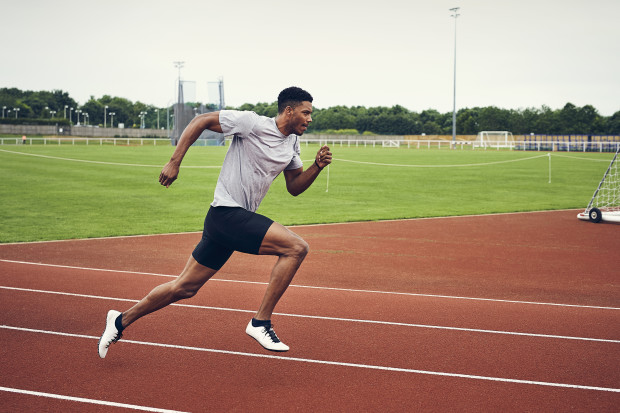The best cardio for weight loss isn't slogging away on a treadmill. Shocking, we know. When people set out to lose weight, their mission usually begins in one familiar place: the treadmill. In fact, this old gym touchstone—that cardio equals weight loss—is so well-worn that it's practically a law of the universe. People think, "I need to keep my weight down, so I'll do more cardio," then trundle over to their treadmill for 45 minutes of mostly unpleasant sweating. But here's the thing: Cardio doesn't necessarily translate to weight loss. In fact, one could argue they're two totally different modes of training.
"I think a lot of people look at cardio as the easy way out toward weight loss," says Matthew Ibrahim, C.S.C.S. "Going for a run without any direction or specific goal is easy to do, and we often see people who do this for years without any real body composition change."
Sound familiar? While you shouldn't necessarily equate cardio with losing weight, you can do cardio for weight loss if you go about it correctly.
What Is Cardio?
"Cardio is better termed 'conditioning,' because you're trying to tap into the different energy systems to elicit an adaptation to the body," Ibrahim says. "You're conditioning the body to work at varying intensities."
Hear that? t all cardio workouts are created equal, and they affect your body's energy-burning systems in different ways. There are three different types of cardio:
- Anaerobic alactic: Short, intense energy spurts that last about 20 seconds, anaerobic workouts increase your maximal strength, speed, and/or power. Example: 100-meter sprint.
- Anaerobic lactic: This system kicks in after 20 seconds of maximum effort, and provides energy for activities lasting up to a minute. Your body will start to produce lactic acid. Example: 400-meter sprint.
- Aerobic: This system gives energy to longer bouts of activity by breaking down carbs, amino acids, and fatty acids. Unlike the other two forms of cardio workouts, aerobic workouts use oxygen. Example: 10K
Benefits of Cardio
A 21-year longitudinal study that followed roughly 1,000 adults (ages 50 and older) found 85 percent of runners were still alive, while only 66 percent of non-runners were, inferring cardio can aid in longevity.
Unlike swimming, rowing, and working out on the elliptical, running is a high-impact sport. While that can sometimes lead to overuse injuries over time, it's great for strengthening your bones and actually helps bulletproof your knees.
Ultramarathons and marathons can temporarily hinder your immunity, but a British Journal of Sports Medicine study suggests people who perform aerobic activity at least five days a week suffer from upper respiratory tract infections 43 percent less often than those who engage in less aerobic activity. And, if runners do get sick, their symptoms aren't as severe.
Moreover, running strengthens your heart while lowering your resting heart rate, blood pressure, and cholesterol. Aerobic exercise is, by far, the most time-efficient form of exercise for improving your heart health, according to research published in The American Journal of Cardiology.
Can Cardio Burn Belly Fat?
As you age, weight tends to accumulate around your belly. However, a Medicine & Science in Sports & Exercise study of more than 100,000 runners found those who ran 35 or more miles per week gained less belly fat throughout their mid-life years than those who ran fewer than nine miles. Logging long miles obviously torches a good amount of calories, but you don't have to focus on volume if you hone in on intensity.
Nix the mindset that cardio only entails mind-numbing treadmill runs, uninspired rides on a stationary bike, and jogs around your neighborhood. The best cardio for weight loss targets specific heart rate zones or levels of intensity during each session. In general, workouts that rev your heart rate near your maximum are essential for boosting your VO2 max, or your overall aerobic capacity—that's what we call "conditioning." Slightly lower-intensity aerobic workouts make it easier for your body to burn fat—although you will not necessarily burn as many calories. (More on this in a moment.)
Does Cardio or Strength Training Burn More Fat?
Doing strength training at the gym for an hour can burn about 300 calories, whereas a typical hour-long run will burn about twice that.
If you're solely looking to cut overall body mass, cardio is optimal—but the best exercise to lose weight combines cardio with strength training, according to research published in the Journal of Applied Physiology. In that study, nearly 120 overweight men and women did one of three workouts for eight months: resistance training, aerobic training (cardio), or a combination of the two.
People who did aerobic training or the combined protocol reduced more total body fat than people who just did strength training. However, people who did resistance training and the combined regimen boosted lean body mass more than plain cardio did. So if you're "skinny fat" and looking to hone greater muscle definition, combining cardio workouts and high-intensity interval training (HIIT) is your best bet.
Utilizing the right bodyweight exercises to burn fat and HIIT routines that incorporate weights are effective for both building muscle and losing weight. Think of it as a hybrid of cardio and strength training. What's more, when you combine tough, heart-rate-revving work with very little rest, your body will start to trigger EPOC, or excess post-exercise oxygen consumption. That means you'll torch more calories post-workout (often called the "afterburn" effect).
"In reality, a balanced combination of proper nutritional intake, strength training, and cardio is what gets the job done most effectively," Ibrahim says. "Cardio alone is not the answer."
You can expect to see results after a four-week workout plan, just be sure to dial in your nutrition. You know that guy who does 45 minutes on the elliptical, then eats two donuts for breakfast? He's wasting his time, because he just ate back every calorie he burned.
Do you need to do cardio every day to lose weight? . But you do need to maintain a calorie deficit—that is, burn more calories than you consume. It's essential for burning fat, and no amount of cardio can reverse that.
Can Excessive Cardio Increase Muscle Loss?
Three days worth of conditioning won't deplete your muscle mass, but more than four days a week likely will. Your body will drop muscle with constant low-intensity exercise to optimize your size for the task at hand (a.k.a. you'll develop the stringy body of a long-distance runner). All that time spent doing cardio takes away from strength training, which obviously yields greater muscle preservation and gains.
When it comes to the best cardio for weight loss, you have to decide which lean body type you’re going for.
As noted, “If you train like a distance runner, you’ll get a distance runner's body: little muscle, very lean from lots of miles logged at relatively slower paces. If you train like a sprinter (i.e. short-burst HIIT workouts), you’ll get a sprinter's body with muscle growth and fat loss," says Chris Ryan, C.S.C.S., a physical trainer and the founder of Chris Ryan Fitness.
Thirty minutes of cardio a day could be enough to burn fat, but intensity is paramount. As the intensity rises, more calories get burned.
Here are the best types of exercise to lose weight faster and get results sooner. Don't worry if you're not a runner. High-intensity cardio comes in all different forms and each is guaranteed to get your heart pumping. te: We've included types of cardio that comprise at-home workouts, track sessions, full-gym routines, and ones that require specific equipment like rowers and ellipticals.
10 Best Cardio Workouts for Weight Loss
1. Sprinting
Sprints outside, on a treadmill, or even up stairs or bleachers are great to burn the most calories in the least amount of time. equipment is really necessary and you can do these workouts just about anywhere.
“Sprinting is simple, and it burns huge amounts of calories—when looking to shed weight, it tops the list. While steady-state running or jogging burns plenty of calories, increasing your speed and intensity will really pay off,” says Adams.”
The best part? Sprinting leaves no muscle unscathed.
The best way to do it:
- If you’re outside on a track, sprint a lap (400m), then jog a lap. Repeat this for as long as you can.
- If you’re on a treadmill, do an all-out sprint for 20 to 30 seconds, then slow the belt down and jog for a minute or so before repeating.
- At a stadium or a flight of stairs? Run up to the top as fast as you can, then jog or walk down. It’s never a good idea to run down stairs or bleachers, so use the downward portion for your active rest periods. Really lift your knees high to activate your glutes and build power.
- If you want a combo of sprinting and plyos, repeat this workout 5 to 10 times with no rest between exercises and just 1 minute between rounds:
- Sprint x 50 yards
- Situps x 50
- Backwards Sprint x 50 yards
- Reverse Crunches x 50
- Burpees x 10
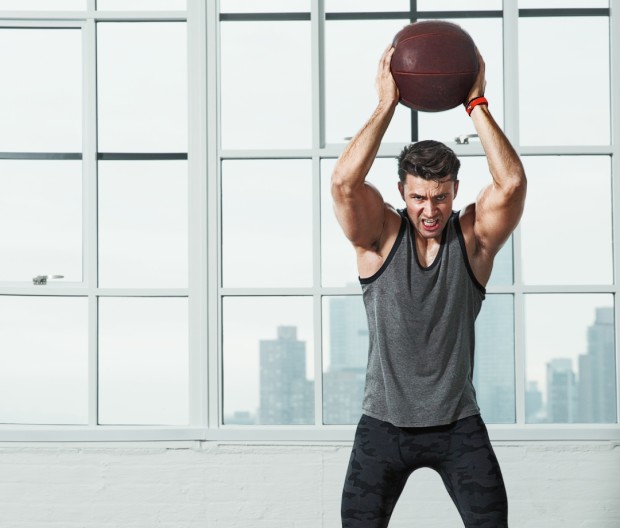
Marius Bugge
2. High-intensity Interval Training
HIIT gives you a well-rounded workout while burning a ton of fat and calories.
“HIIT workouts can vary greatly, from 500 calories per hour to 1500-plus calories per hour for an 180-lb man. HIIT workouts are great because of the intensity of each exercise as well as the variation of exercises and reps,” says Ryan.
Pairing any bodyweight movement with a weighted movement and a traditional cardio element and you have the perfect recipe for an amazing fat-burner.
The best way to do it:
- Look for Tabata, HIIT, and and vigorous interval classes that comprise AMRAPs (as many rounds as possible) and EMOMs (every minute on the minute) using weights at your local gym. Be sure to keep rest periods to a minimum to really maximize your efforts.
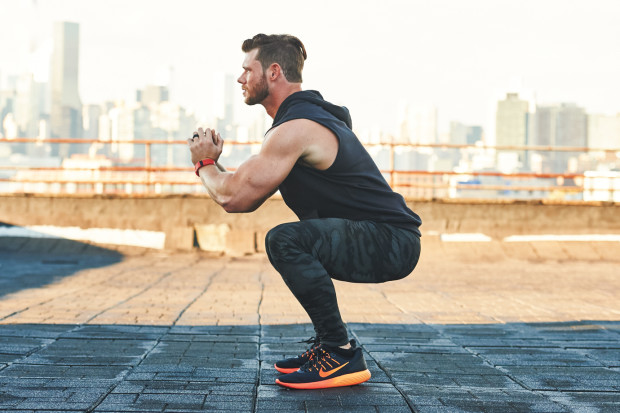
1. 20-Minute Low-impact HIIT
Most quick cardio regimens for weight loss involve high-intensity interval training (HIIT) that leaves you gasping for air. And while they're fantastic for conditioning and dropping fat, all that jumping around can take its toll on your joints so, Pete Williams, CPT, put together a workout to ramp up your metabolism without stressing your body.
In this do-anywhere, bodyweight workout, you'll push hard for 20 minutes to create core stability, open up tight hips, and get a much-needed cardio benefit that's more effective than jogging. We’ve designed this workout by alternating lower body and upper body movements as well as pushing and pulling exercises so there’s no need for rest. This way you can make the most of your time, performing 2 sets of these moves as a circuit.
Forward Lunge-to-Instep x 10 reps each side
How to do it: Start by stepping forward into a lunge with your left foot forward. Place your right forearm (or hand) to the ground and your left elbow to the inside of your left foot (shown here). Hold the stretch for two seconds. Then, place your left hand outside of your foot and push your hips up, pointing your front toes up. Return to standing position and repeat by stepping out with your right foot. Continue alternating sides.
One-arm, One-leg Plank x 10 reps each side
How to do it: From a pushup position with forearms on the ground (shown here), push up and support your weight on your elbows. Tuck your chin so your head is in line with your body. Lift one arm and the opposite leg, hold for two seconds. Switch limbs.
Pullup x 10 reps
How to do it: Grab the bar with an overhand grip. Hanging from the bar, pull your shoulder blades back and down to lift your body up and build momentum. Finish by pulling up with your arms.
3-Way Pushup x 10 reps
How to do it: Do 10 traditional pushups (hands directly below the shoulders) followed by 10 “diamond” pushups (index fingers and triceps touching), followed by 10 wide-grip pushups (hands wider than shoulders).
Squat Jump x 10 reps
How to do it: Stand with feet just outside your shoulders. Squat, keeping your knees behind your toes. After holding this position for two seconds, jump vertically. Pull your toes to your shins midair to prepare for landing. Be sure to land softly, with your hips back and down.
Burpee x 10 reps
How to do it: Squat, place you hands on the ground, and “jump” your feet out into a pushup position. Perform a pushup, then jump your feet to your hands. Then jump as high as you can, throwing your hands over your head.
Mountain Climbers x 30 reps each side
How to do it: This movement mimics mountain climbing. Think of the ground as your mountain. Start in pushup position with the balls of your feet on the ground. Alternate driving your knees forward to their corresponding arm and keep your hips down for the entire motion.
V-up x 15 reps
How to do it: Begin on your back with hands extended over your head. Lift your legs and crunch up at the same time, forming your body into the shape of a “V.” Be sure to lift your legs and trunk simultaneously—doing one ahead of the other makes you lose a lot of the effectiveness of the movement. Exhale as you lift your legs and crunch and inhale as you return to the starting position.
2. 30-Minute Basic Bodyweight Workout
“ gym? problem. Speed up this circuit of bodyweight exercises to burn calories anywhere, anytime,” says Franklin Antoian, CPT. Do the circuit of exercises for 1 minute each. Repeat 4 times through, resting 30 seconds before repeating.
- Pushups
- Jumping Jacks
- Forward-Backward Lunges (30 sec. each leg)
- V-ups
- Side-stepping Squats (30 seconds each leg)
- Burpees
- Mountain Climbers
3. Beast Mode Bodyweight Workout
“This bodyweight circuit workout raises your body temperature and increases your metabolism,” says Lisa Reed, M.S., C.S.C.S. Do the main circuit of exercises for 30 second each. Repeat 2 to 3 times through, resting as little as possible. Finish with the cardio burnout.
- Isometric Squats
- Squats
- Sumo Squat Jumps
- Wide-hand Pushups
- Renegade Row to Pushup
- Side Plank Rotations With Reach
- Reverse Lunges (right)
- Reverse Lunges (left)
- Plank Tricep Getups (right-arm lead)
- Plank Tricep Getups (left-arm lead)
- Windshield Wipers
Finisher
- Speed Squats
- Quick Feet
- Skaters
- Speed Jumping Jacks
- High-knee Stationary Sprint
- Burpees
James Michelfelder
View the 9 images of this gallery on the
original article
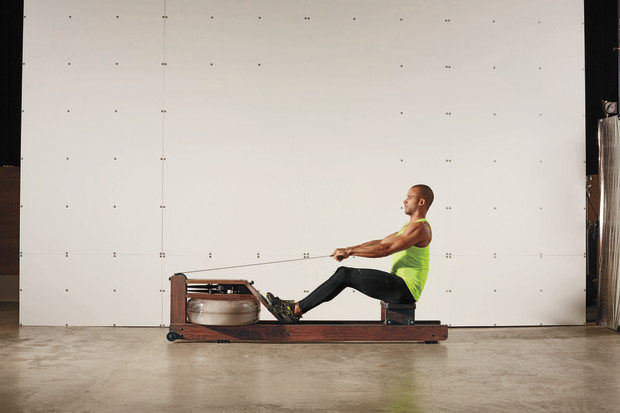
Justin Steele
3. Rowing
Take a look at any collegiate rower's body and you’ll surely be envious of their V-cut frame.
“Rowing makes the list because it's a great way to incorporate the upper and lower body in a relatively low-stress manner on your joints and ligaments. It’s also a great way to work the posterior chain,” explains Ryan.
Following a moderate pace on the rowing machine (erg) can burn upwards of 800 calories per hour for an 180-lb guy, but increasing the intensity with short sprints will get that number well over 1,000 calories per hour very quickly.
The best way to do it:
- Keep your chest up and use your entire body when rowing: Begin by powering through the legs. Then, as you start to hinge back, initiate the pull. That whole process should take 1 second, while the reset takes 2 seconds. Even as your stroke gets faster, that ratio should stay.
- The biggest mistakes is letting your arms do all the work.
- To burn fat fast, set a clock for 20 minutes. Row 250 meters in 1 minute, rest for 1 minute, then repeat.
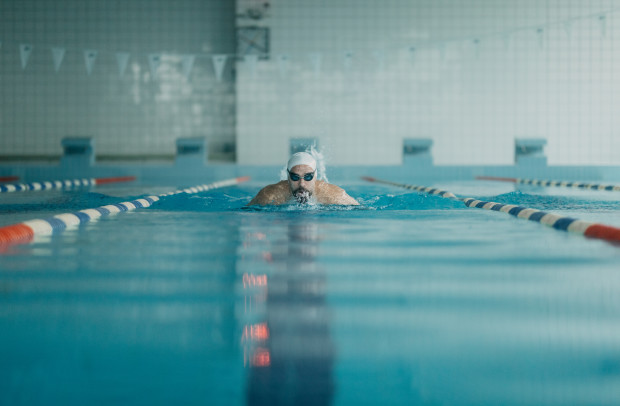
Halfpoint Images / Getty Images
4. Swimming
Swimming is a total-body workout that starts the second you begin treading water.
“You’re essentially fighting gravity, so your muscles are working extra hard to keep you afloat without getting a break until you’re out of the water. In fact, with just one minute of fast swimming, you’ll burn 14 calories.” says Boudro.
“Remember that the type of stroke makes a difference. A breast stroke burns fewer calories than the butterfly, so be sure to incorporate different strokes in your training,” Adams says.
The best way to do it:
- An easy way to burn calories in the water is to simply tread water. You can do a few laps, then have a water-treading interval, and repeat.
- If you’re able to swim at a high level, swim as fast as you can for as long as possible.
- If you aren’t such a strong swimmer, do swimming intervals: Swim as fast as you can down the length of the pool and back, then swim slower for the same distance. Alternate these intervals for the duration of your workout.
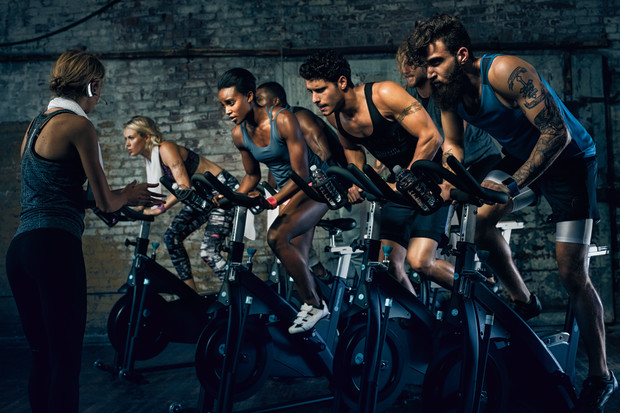
Jorg Badura
5. Cycling
Stationary bikes are a mainstay at most gyms, but there’s a reason most people aren’t waiting in line to use them.
“You must be willing to go at an intense rate. So no pedaling while scrolling through your smartphone. During a vigorous indoor spin class, the average 180-lb. man may burn close to 1,150 calories per hour, while a more moderate ride will only burn half that amount at about 675 calories per hour,” says Adams. If you want a quick burn, do sprint intervals on an Airdyne bike.
The best way to do it:
- Keep the intensity really high on the intervals for a couple of minutes, then slow down for a minute or so, continually repeating these intervals for as long as you can.
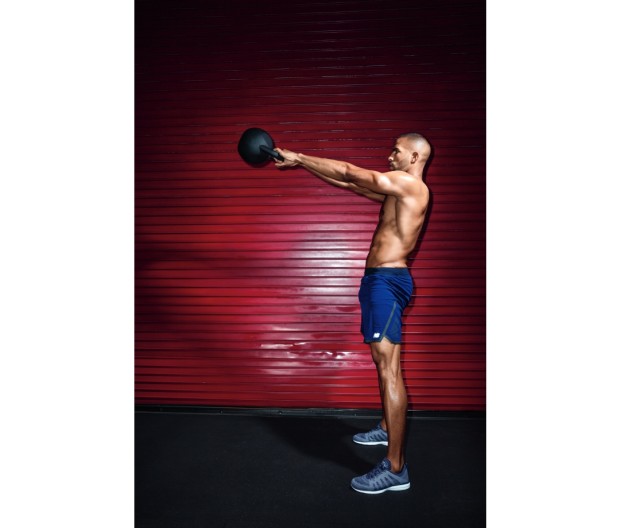
Ian Maddox
6. Kettlebells
While a kettlebell workout isn’t technically a cardio-only exercise, its calorie-burning effects are too high to keep off this list.
Why it works
“Kettlebell workouts combine the best of both worlds: strength training and cardio,” says Adams. “In addition, a recent study on the calorie-burning effects of this type of workout puts it at around 20 calories per minute. This total takes into account not only the aerobic calorie expenditure, but also the anaerobic calories burned. Very few cardio exercises build muscle—this is one of the exceptions. You can expect to burn around 400 to 600 calories in just 30 minutes,” says Adams.
Kettlebells are more effective than dumbbells for improving aerobic capacity, according to research. The study, done at San Jose University, found that participants who trained for 20 minutes three days per week with kettlebells increased aerobic capacity by 6 percent, while a group who trained with dumbbells saw no increase. That's because the moves you do with kettlebells are typically more dynamic than the ones you do with dumbbells, so you can more easily spike your heart rate, the study authors say.
And by increasing your heart rate, you also increase the number of calories—and amount of fat—you shed during the workout. But unlike running or cycling—workouts typically associated with amping heart rate and aerobic capacity—doing a high intensity kettlebell routine also builds muscle. Talk about saving major time at the gym.
"HIIT kettlebell training is a great way to add cardio to your strength workouts," confirms Felix Bangkuai, CPT.
If you hit the gym three times a week, focus on total-body strength training your first two days, and metabolic conditioning (“cardio”) on the third. And remember, there’s no need to lope along on the treadmill or bore yourself with an endless stairmaster climb. Try incorporating kettlebell swings and ropes or flip over that TRX for an easy transition from rows to jump squats.
Make traditional strength training your bread and butter, and end with cardio. Close out a 40-minute workout session with 5 to 10 minutes of post-workout anaerobic conditioning. For example, consider 30-second sprints on the bike followed by a minute of rest. Repeat three times and you’re done.
When it comes to intervals, go 30 seconds on and 60 seconds off. Resting twice as long allows you to get a true interval, and makes recovery a positive work period. As opposed to Tabata, which is 20 seconds on and 10 off, the extended rest allows you to push past your anaerobic conditioning point for a more complete recovery, allowing you to go harder for the next set.
Don’t make the mistake of doing hard cardio. Instead of pacing yourself, take complete breaks. Use a heart-rate monitor to make sure you go hard enough to get into the “red zone”—85 percent of your maximum anaerobic threshold—and don’t start again until you’ve transitioned to the “green zone,” 0 to 75 percent of your max heart rate. Think of the “yellow zone”—76 to 84 percent—as a transitional zone. You might feel like you can go again in the yellow, but waiting for the green allows you to produce more power and strength the next time rather than struggling to maintain crappy cardio.
The best way to do it:
- If you can do a particular movement for 40-50 reps, chances are your kettlebell isn’t heavy enough. Don’t go too light, and don’t go too heavy either.
- Some of the best ways to do a kettlebell workout to maximize calorie burning is to do a movement for 30-40 seconds, rest for 20-30 seconds, then repeat the movement or cycle through several.
- Set your timer for 30 minutes and see how many rounds you can get.
Best Kettlebell Workouts for Weight Loss
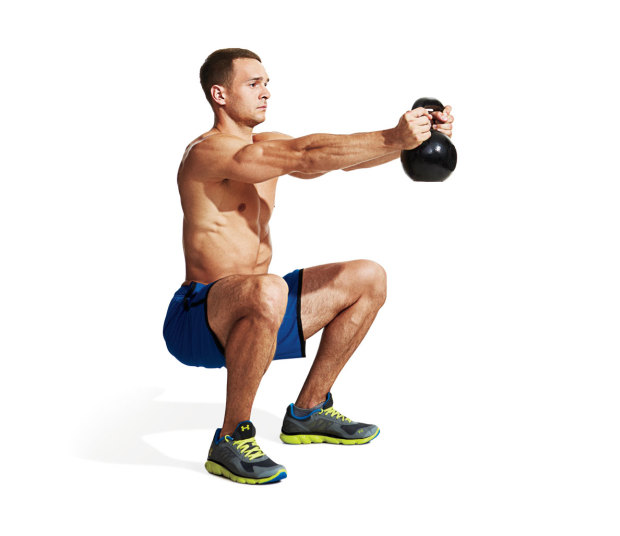
Rest as little as possible between exercises. You may rest 1 minute between rounds. Use the same weight for the entire circuit.
Do 3 to 4 sets of 12 to 15 reps:
- Goblet Squat
- Single-arm Bentover Row
- Kettlebell Deadlift
- Kettlebell Push Press
- Kettlebell Pushup
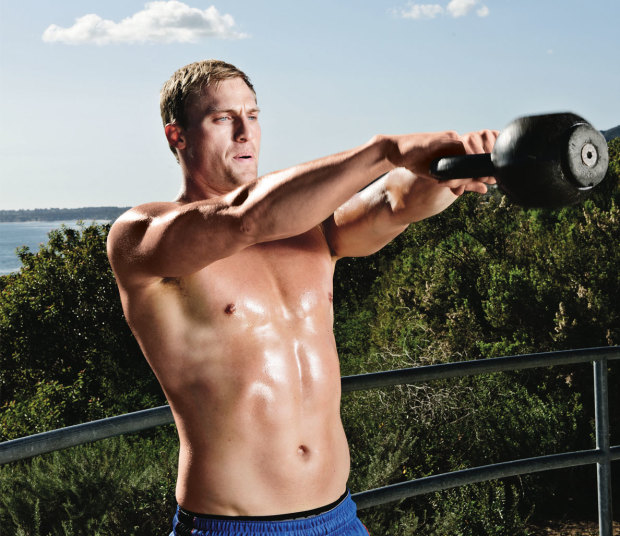
Rest as little as possible between exercises. You may rest 1 minute between rounds. Use the same weight for the entire circuit.
Do 3 to 4 sets of 12 to 15 reps:
- Front Squat
- Push Press
- Romanian Deadlift
- Bentover Row
- Reverse Lunge
- Kettlebell Swing
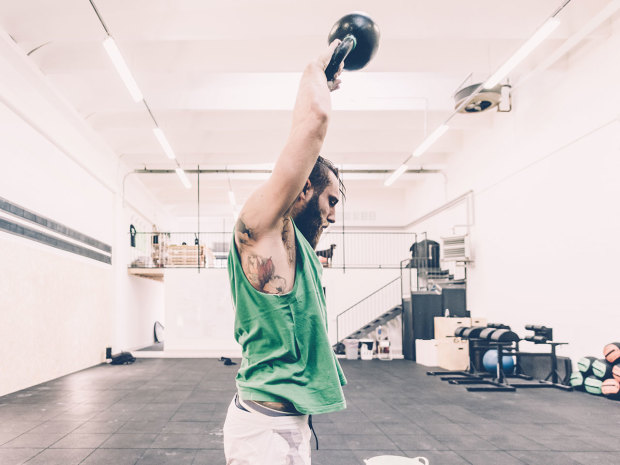
For the first round, do 15 reps and start with a relatively light weight (20 lbs). Next, do 12 reps and slightly more weight. Break only to catch your breath as you transition between exercises. Do this one for time (30 min max). Follow the same pattern for the third and (optional) fourth rounds.
Do 3 to 4 rounds as fast as you can:
- Kettlebell Swing
- Kettlebell Press
- Overhead Squat
- Kettlebell Clean
- Alternating Kettlebell Row
- Jump Squats (hold kettlebell at chest)
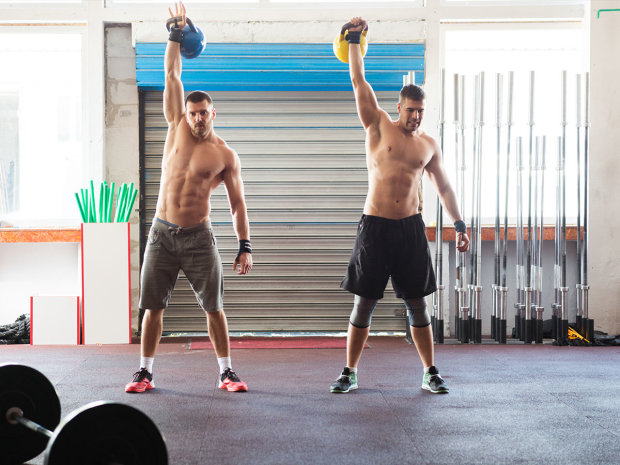
Break only to catch your breath as you transition between exercises. Maintain the same weight for the entire circuit. Start with your weaker side first to ensure balance.
Do 3 to 4 sets of 12 to 15 reps:
- Kettlebell Clean
- Kettlebell Front Squat
- Single-arm Press
- Kettlebell Offset Lunge
- Single-arm Kettlebell Swing
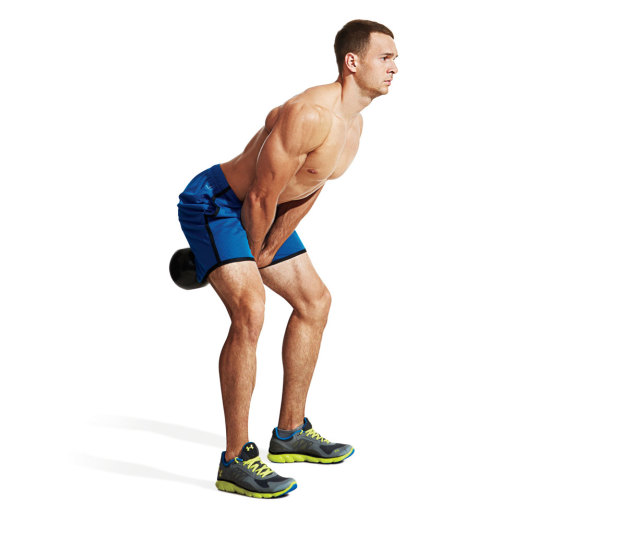
Break only to catch your breath as you transition between exercises. Maintain the same weight for the entire circuit, except for the kettlebell swing—use 1.5 to twice as much weight for that specific exercise.
Do 3 to 4 sets of 12 to 15 reps:
- Kettlebell Thruster
- Kettlebell Pendlay Row
- Kettlebell Romanian Deadlift
- Kettlebell Swing
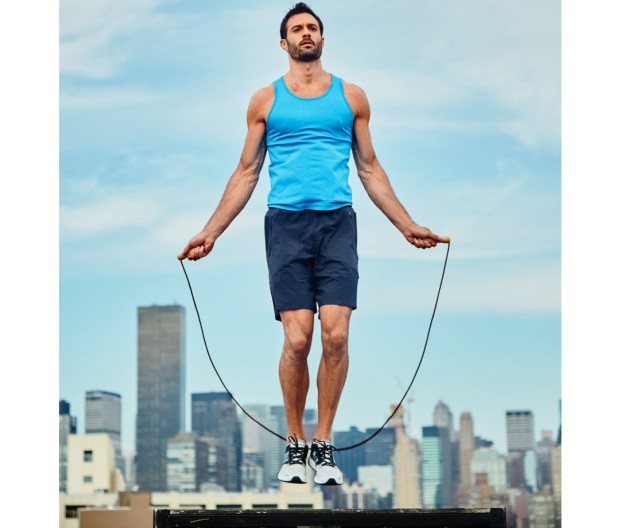
Justin Steele
7. Jumping Rope
There’s a reason the jump rope is a mainstay in a boxer’s training regimen: it’s cheap, easy to do, increases foot speed, and burns a ton of calories. Think of your favorite boxers, wrestlers, and fighters—they all jump rope.
“Jumping rope not only enhances your footwork, shoulder strength, and coordination, but also simulates sprinting, allowing you to burn as much as 500 calories in just 30 minutes,” says Ben Boudro, C.S.C.S., owner of Xceleration Fitness in Auburn Hills, MI.
The best way to do it:
- While very few people can jump rope for 30 minutes straight, it's best to do intervals of fast and slow jumps to keep you going.
- Can’t do that very well? Jump as fast as you can for one minute, then rest for 20-30 seconds. Repeat until you’re done.
- If you’re a frequent traveler, throw a jump rope in your suitcase for a great workout without ever having to leave the hotel room.
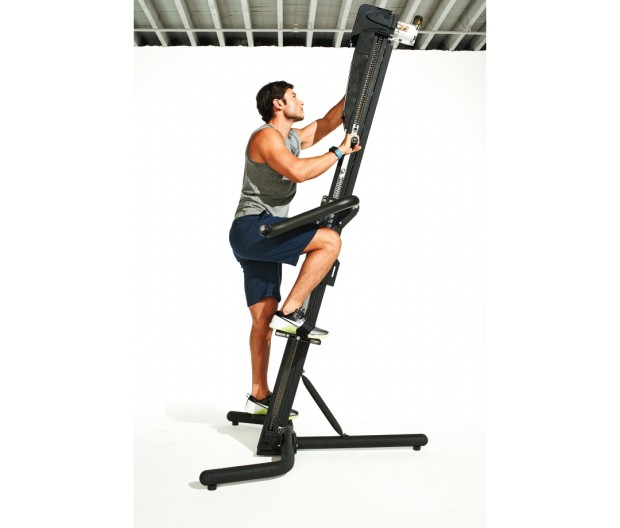
Marius Bugge
8. Stair Climber or VersaClimber
A stair climber offers another popular way to burn fat and calories, but only about 500-600 calories for an 180-lb. man at a moderate pace.
“Because of the higher leg lift involved, climbing stairs uses significantly more muscles than just walking—strengthening your legs in a functional way,” says Adams.
Stair climbers can put a lot of weight and pressure on your joints, so it can be difficult for people with bad knees.
The best way to do it:
- “Try incorporating 90 percent or more effort on the stair climber for 30 seconds with a one- to two-minute 'active recovery,' like a farmer carrying medium-weight kettlebells or dumbbells to incorporate upper body and core strength,” says Ryan.
- Doing 10-15 rounds of this workout will spice up your workout way above the normal range of calories burned.
If you want to burn fat without the impact on your joints, utilize the VersaClimber. A Washington State University study found that subjects’ maximal heart rates were jacked up higher when doing VersaClimber intervals than when running intervals on a treadmill, and their VO2 max—a measure of how fast the body consumes oxygen, which correlates to calories burned—was “significantly greater” when climbing than when training on a treadmill or a rowing machine.
“The VersaClimber burns more calories than anything else out there,” says Jason Walsh, C.S.C.S., a trainer who teaches at Rise Nation in LA. “I’d estimate between 600 to 800 calories for a 30-minute session.”
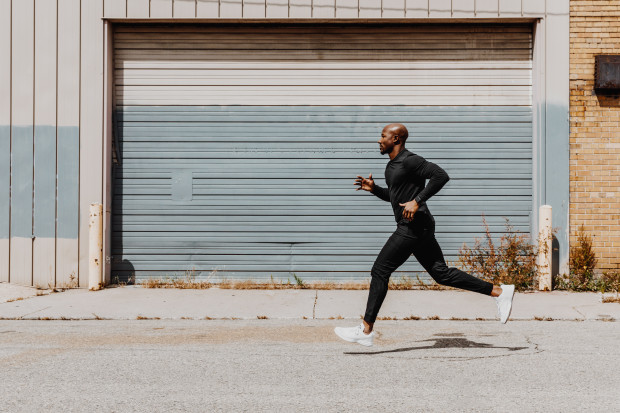
9. Running (Moderate Pace)
Running at a steady, moderate pace is a sure way to burn fat and calories, but it’s not the most economical way to build or even maintain muscle.
“By the numbers, a 180-lb. man can burn about 940 calories in an hour while running an 8.5-minute-per-mile pace—or 7 mph on the treadmill for an hour. This would be a nice, long run to do every couple of weeks to keep up your aerobic capacity, but it involves a lot of mileage for the time and effort put in.” says Ryan.
The cons:
Running at this pace can also break down muscle and subject your body to lots of pounding.
“If you’re looking to add in a long run every once in a while, by all means do so, just opt for trails or softer surfaces than cement and blacktop,” he says.
The best way to do it:
- If running feels boring for you, try different routes in your neighborhood or join a local running club. Running with a partner or group can make the miles go by much easier.
- If you’re running on a treadmill, set the incline to 2-3% to simulate running outside. "This burns more calories and may actually be easier on the knees." suggests Adams.
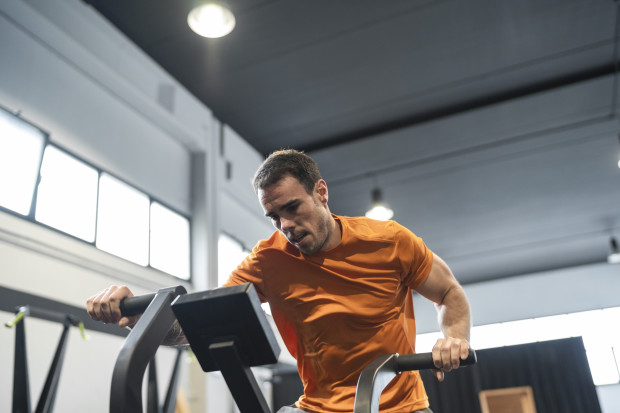
Getty Images
10. Elliptical Machine
These machines were originally designed to minimize impact on the knees and hips, but still allow a great workout.
“Because the impact is quite low, the calorie-burning effect isn’t as great as other cardio machines, like treadmills and stairmasters. However, the elliptical machine can be an excellent way to burn calories without wearing out your joints.” Explains Roger Adams, Ph.D., an expert in nutrition and weight loss.
While the average weight is 180 pounds, a man may only burn close to 500 to 600 calories per hour if he’s going at an above moderate pace, you can get even more out of it by switching up the intensity, speed, and resistance.
The best way to do it:
- Add a high incline to activate more muscles, especially your glutes. “This movement can simulate stair-climbing without the impact. Lower the incline and increase the resistance and you have a cross-country skiing feel to your workout that really works your quads." says Adams.
- Don’t hold on to the handles or rails too tightly as this can reduce your effort and lead to shoulder or wrist pain.

